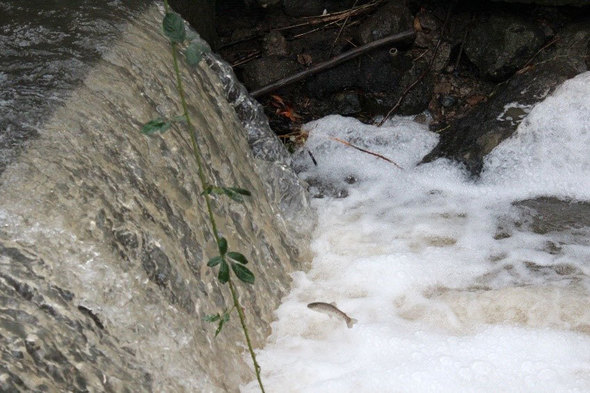|
December 2016
Hello, First Name
This email is the first in a series intended to share information and provide facts related to the fish resources of the Rogue River and management of those resources. I hope you find this information both interesting and helpful.
This is an exciting time on the Rogue! A lot of good work is being done to give our fish the best chance to thrive in a future that looks increasingly chaotic for natural systems. I hope you will consider giving your time to protect and restore habitat in the watershed and help grow more fish.
Dan Van Dyke
Rogue District Fish Biologist
 Fall chinook entering Applegate River late September 2016. ODFW photo.
Chinook salmon update
The spawning cycle for
native fish in the Rogue is well
underway—see
the table below. Spring Chinook salmon have all spawned. ODFW now monitors
the abundance of Rogue Spring Chinook by counting the carcasses of spawned fish. Our
estimate of abundance in 2016 is about 9,500 wild fish. You can follow the
Spring Chinook counts in our annual reports.
Rogue Watershed Spawning Cycle
Spring Chinook: September-early October
Fall Chinook: October-January; spawning later with distance downstream
Coho Salmon: roughly late November through mid-January
Summer Steelhead: mid-December through mid-March
Cutthroat Trout: similar to Summer Steelhead
Winter Steelhead: mid-March through June
Suckers: April
Pacific Lamprey: roughly April-June
Fall Chinook are almost done spawning. Our estimate of
abundance in 2016 is about 29,000 fall chinook, a below average return but
still above levels that are a conservation concern. You can follow the Fall
Chinook counts in our annual
reports.
The monitoring is done at our
Huntley Park seining project. You can see what we collect at Huntley by
checking the biweekly totals. The sampling time frame
for Huntley is mid-July through the end of October.
Did you
know? We have around 40 million Fall Chinook eggs incubating in the
gravel of the Rogue Watershed today (assuming half our 29,000 Fall Chinook were
females averaging 3,000 eggs per female)!
Coho salmon update
Coho salmon are spawning now,
using low gradient tributaries of our larger streams, the tributaries of Big
Butte Creek, Elk Creek, Little Butte Creek, Bear Creek, Evans Creek, the Applegate
and Illinois rivers and some direct tributaries of the Rogue.
ODFW estimates the abundance of
spawning Coho Salmon in the Rogue by comparing the number of unmarked wild Coho
to marked hatchery Coho collected at the Huntley Park seining
project. After the hatchery fish return to Cole Rivers Fish Hatchery, we can produce a very good estimate of the number of wild Coho
returning to spawn that year.
Wacky weather and Coho
Coho Salmon hatch in the
springtime and typically live in the tributary stream for a year before heading
to sea. Hot weather and drought are bad news for Coho. The Coho
returning to spawn this year were produced by fish that spawned in 2013 during
the driest calendar year on record in Medford (and the third warmest summer on
record). The young fish then had to survive the drought in 2014 before
heading to sea during the drought of 2015. And, these same fish faced one
of the strongest El Ninos on record in 2015-2016.
You can help our fish by
protecting and restoring riparian trees and shrubs which keep streams cooler in
hot weather. November and December is the best time to plant potted trees
in riparian areas. The ground is warmer than the air and will promote good
root growth. Willows will grow from cuttings taken December through
February from existing plants. If your property borders a stream, consider
planting native trees, or call ODFW for more guidance.

|